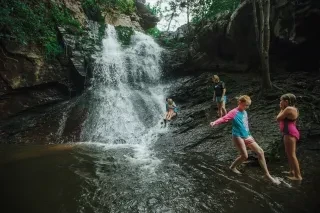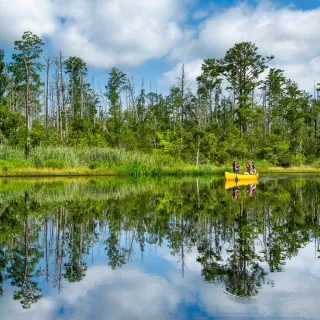
Hero - Interior Page Hero Module
Listicle View
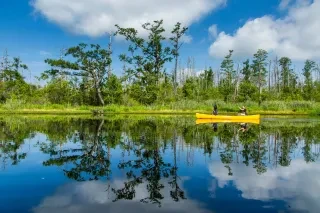
Alligator River National Wildlife Refuge
Located on the mainland of Dare and Hyde counties just 15 miles from the Outer Banks, this refuge preserves the pocosin habitat — a special type of wetland — and is a haven for black bears, American alligators, red wolves, waterfowl and other birds. Kayaking or canoeing the creeks here get you close to the wildlife (you may even hear a wolf howling), and hunters and anglers brave the woods throughout the year.
Cedar Island National Wildlife Refuge
This 15,000-acre refuge comprises brackish marsh and a mixed pocosin-woodland habitat, and many types of waterfowl winter here. Though easily accessible, Cedar Island offers solitude, undisturbed nature and the opportunity to observe sensitive species in a protected environment. Anglers come for the inshore fishing; boaters and kayakers to explore the islands, coves and creeks; and hunters get in on the action in season.
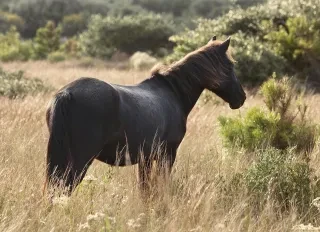
Currituck National Wildlife Refuge
Protecting the fragile beach, dune and maritime forest ecosystems at the far northern end of the Outer Banks, Currituck is home to wading birds, shorebirds and waterfowl; reptiles and amphibians; and the stars of the show: the Colonial Spanish Mustangs. Visitors can take an off-road jeep tour to look for feral horses and other wildlife, hike through the refuge, go kayaking, or, in season, enjoy hunting and fishing among the marshy islands here.
Mackay Island National Wildlife Refuge
This marsh habitat tucked against our northern border on the Outer Banks is a key wintering area for ducks, geese and tundra swans, and at times flocks of 12,000 snow geese fill the sky and waters, making an impressive sight. The Charles Kuralt Trail, an elevated platform lined with spotting scopes overlooking the Great Marsh, gives every visitor the chance to be a bird watcher. Hikers, boaters, anglers and hunters head here for the unspoiled nature and the birds.
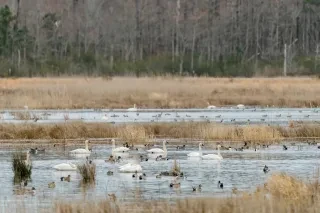
Mattamuskeet National Wildlife Refuge
Lake Mattamuskeet, the largest natural lake in North Carolina, serves as centerpiece for this wildlife refuge. Roads ring the lake and birds come here by the thousands. Bird watchers, nature photographers, hikers and bikers come here to observe, record and explore, while others — hunters and anglers — come for a catch they won’t soon forget. Located on the Atlantic Flyway, the wildlife refuge stays busy with visiting birds much of the year.
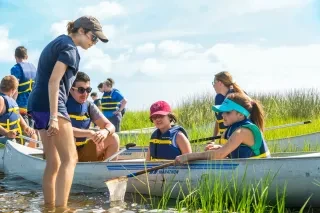
Pea Island National Wildlife Refuge
A popular feeding and resting area for wintering waterfowl and migrating shorebirds and songbirds as well as a 13-mile stretch of pristine ocean beach providing nesting habitats for loggerhead sea turtles, Pea Island National Wildlife Refuge is a diverse, valuable and easy-to-visit refuge. Located at the north end of Hatteras Island on the Outer Banks, more than 2.5 million visitors stop in annually to walk the trails, use the photography blind and observation tower, and swim.
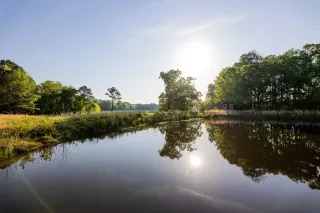
Pee Dee National Wildlife Refuge
This 8,500-acre refuge was established to give 10,000-plus birds a place to winter each year. Waterfowl are here in great numbers, but neo-tropical migratory birds, bobwhite quail and wild turkey call this protected patch of land home too. As you tour by car or as you hike or hunt, don’t be surprised to see white-tail deer here as well.
Pocosin Lakes National Wildlife Refuge
The 110,000-acre Pocosin Lakes National Wildlife Refuge provides the opportunity for visitors and photographers to catch tundra swans, snow geese and ducks, as well as deer, black bear and other wildlife in their habitat. Experience the refuge at the visitors center or on tours to search for bear, birds, wildflowers and more.
Roanoke River National Wildlife Refuge
Along 70 miles of the Roanoke River, five protected areas provide nesting and wintering area for migratory waterfowl, ducks, raptors, osprey and neo-tropical migratory birds, including what is believed to be the largest inland heron rookery in North Carolina. Bird watchers gather here, but so do anglers who come in search of rock bass. Hiking and walking trails, like the Underground Railroad Trail, get visitors immersed in the history, woods and waters. Plus, interpretive programs — from simple signage to ranger-led walks — provide additional enlightenment on the flora and fauna in the refuge.
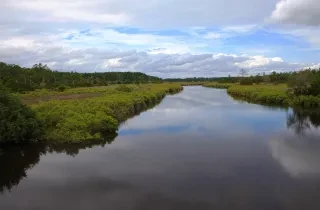
Swanquarter National Wildlife Refuge
A 16,000-plus-acre patch of salt marsh and forested wetland on the Pamlico Sound provides winter sanctuary for black ducks, canvasbacks, redheads and scaup, but also habitat for nesting osprey and colonial waterbirds; the American alligator also calls Swanquarter National Wildlife Refuge home. Visitors come for boating (multiple ramps provide water access), saltwater fishing and waterfowl hunting, but wildlife photographers find year-round opportunities to capture that perfect shot in a pristine place.
Plan your visit
The National Wildlife Refuges Visitor Center in Manteo serves as a gateway for the 10 visitor-friendly refuges, offering information on each as well as interactive exhibits and a gift shop complete with nearly everything you need to enjoy a few days of wildlife watching. And don't forget to check out our Guide to Birding in NC before heading out.
Visit Outdoor NC for additional tips on how to connect with nature and help preserve the natural beauty of our state, plus fishing information for keeping NC's waters pristine and wildlife safe.
